Anna Barham
Anna Barham
s dark blank, a littlest song sang herself, 2021
Ink on paper, plastic, engraved acrylic, aluminium frame
35.8 × 32.8 × 3.5 cm | 14.1 × 12.9 × 1.4 in


Anna Barham came so interested that she sang herself, 2021 Ink on paper, engraved acrylic, aluminium frame 35.8 × 32.8 × 3.5 cm | 14.1 × 12.9 × 1.4 in
Anna Barham

Now forget everything you ever knew or thought, 2021 I nk on paper, printed acrylic, aluminium frame 35.8 × 32.8 × 3.5 cm | 14.1 × 12.9 × 1.4 in
Florian Baudrexel
Florian Baudrexel
Untitled, 2022 Printed cardboard, wood, acrylic glass box 40.8 × 40.8 × 11 cm | 16.1 × 16.1 × 4.3 in

Florian Baudrexel Untitled, 2022 Printed cardboard, wood, acrylic glass box 40.8 × 40.8 × 11 cm | 16.1 × 16.1 × 4.3 in

Erica Baum

Erica Baum
Wishes (Dog Ear), 2014 Archival pigment print Edition 1 of 6 + II AP 22.9 × 22.9 cm | 9 × 9 in

Erica Baum Venice (Dog Ear), 2014 Archival pigment print Edition 1 of 6 + II AP 22.9 × 22.9 cm | 9 × 9 in
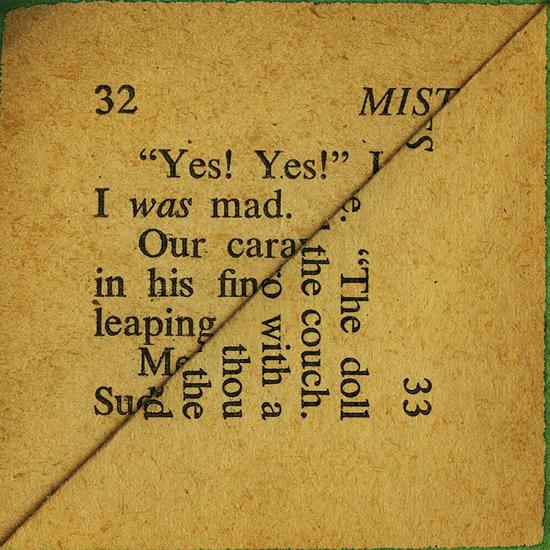
Erica Baum Mad(Dog Ear), 2009 Archival pigment print Edition 1 of 6 + II AP 22.9 × 22.9 cm | 9 × 9 in

Erica Baum Spare (Dog Ear), 2009 Archival pigment print Edition 1 of 6 + II AP 22.9 × 22.9 cm | 9 × 9 in

Moyra Davey Moyra Davey Endless Love, 2017 Eight C-Prints, tape, postage and ink 63.6 × 188 cm | 25 × 74 in



Tacita Dean
The great god Pan

Tacita Dean
is dead, 2021 Collage on vintage index card 10.2 × 15.2 cm | 4 × 6 in

Tacita Dean Pan (not in evidence), 2021 Collage on vintage index card 10.2 × 15.2 cm | 4 × 6 in

Tacita Dean Panselinos, 2021 Collage on vintage index card 10.2 × 15.2 cm | 4 × 6 in

Tacita Dean Pan (rhubarb), 2021 Collage on vintage index card 10.2 × 15.2 cm | 4 × 6 in
Mathew Hale
The Origin of the Work,
Mathew Hale
2018 - 2022 Printed and cut paper collage, pencil, silver pen, tag and cotton string 22 × 22 × 0.7 cm | 8.7 × 8.7 × 0.3 in



Mathew

Hale “May the 6th, 2023” (Page 61 of TWO MIRIAMS & THEIR MOTHER), 1992 – 2022 Printed, typed and cut paper collage, acrylic paint 45.7 × 45.7 × 5 cm | 18 × 18 × 2 in

One of the most striking things about Emily Dickinson’s envelope poems is the way in which the shape of the support helps to decide the shape of the text. To make the poem on the left, dated 1873, an envelope was carefully unfolded, and a scalpel was used to incise a rectangle, a little bit of paper left dangling from a corner. The paper surface was turned to a 45° angle on a wooden lap desk and only then did Dickinson begin to write, allowing the interventions to determine where each line started as well as the spaces between words. The envelope’s shape even impacted on the integrity of words. ‘And yet we know / that gentle clock / Meant nought / but / going home.’ When it reaches the incision, the word ‘meant’ is cut in two: ‘me – ant’. A small violence is inflicted on meaning, invisible when the poem is reproduced in print. Likewise, ‘Esoteric time’, with which the poem ends, is also time out of joint: ‘tim / e’.
It would be interesting to know how much Dickinson improvised, if she knew what she was going to write before putting pencil to paper. Did a crease, fold or cut change the content of the poem as she wrote? Was the line ‘going home’ written next to the incision to suggest that home was, for Dickinson, something akin to an absence, a void, a cut? Or did the poem take shape in her mind and according to the characteristics of the support, only then to be written down? I would hazard that she used the envelopes as constraints, which, paradoxically perhaps, gave her the freedom to improvise. This helps to account for why, when a word gets close to an edge or corner, letters are sometimes twisted out of shape, bunched up, or forced down a line. The problem Dickinson faced was not only how to end but how to continue.
FOLDS
The folds used to make an envelope typically take the form of a rhombus, a short arm cross, or a kite. In Dickinson’s poems these structures were sliced or steamed apart, gently pulled out of shape, flattened, and cut. While the support she chose to write on can make the poems look throwaway, unspoken for, like flotsam and jetsam, as if she had just picked up any old scrap of paper and decided to write on it (‘scrap’ is a word often used to describe these poems), the artist Jen Bervin was right when she observed just how deliberate and meticulous the preparatory process was. ‘What looks simple, simply is not.’1 The surface of Dickinson’s lap desk, now at Amherst College Library, ‘is positively riddled with myriad fine cuts.’2 Envelopes were treated like specimens in a natural history museum, dissected and decomposed, then carefully stored in a draw.
The envelope poems are at once deeply personal and anonymous. To read them is to be invited into an intimate paper world usually reserved for the recipient of a love letter. I have only ever seen them in facsimile, but it is easy to imagine how delicate they would feel in the hand, how the smaller fragments would ask to be held in the palm, as might a bird, or a butterfly. This intimacy is belied by a sense of distance or detachment, a common experience when reading Dickinson. It is unclear for whom they were written –a prolific writer, she published only ten poems in her lifetime, all anonymously – and while Dickinson uses words to become her own observer, she does so in an elliptical, almost encrypted way. Even when you get this close you never really feel like you know her. That the poems were written on the surface of envelopes adds to this affect: meaning would usually be concealed within an envelope and not without, which suggests that a surface reading, where your eye just follows the shape of the letter, could be as appropriate as a search for deeper meaning.
As the envelope poems intimate, Dickinson wrote many letters: at least 1150. Only one half of the correspondence survives, because Lavinia Dickinson, following her sister’s wishes, burnt the other half after her death in 1886. Few copies of Dickinson’s own epistles exist, and the ones that do were victims of ‘scissored deletions,’3 as one of her biographers put it. Details were literally cut out by Lavinia to protect her sister’s privacy. Most obscure are the three ‘Master letters’, which were addressed to the Master, who Dickinson never names. These letters are unusual for adopting a tone both passionate and pleading. Nobody knows who the Master was, or indeed if the Master ever existed. Was the Master a lover, an omnipotent object, like God or the Devil, an alterego? We will never know. What matters, though, is that for Dickinson the process of writing needed an addressee – in phantasy or in reality – with which to commune. Though she worked alone, within the confines of her bedroom, often at night, the epistolary form facilitated that process,


in both her internal and external worlds. We never write to no one; a letter always has an addressee, even when it doesn’t.
In the digital era, it would be easy to lend the envelopes a nostalgic character they were unlikely to possess. The historian James Ward has described how it was only after 1840, with the invention of machines able to tesselate, cut, fold, and press sheets of paper, that envelopes were commonly used when sending letters.4 Until then the page was simply folded in half. When Dickinson was working on her poems, machine-made envelopes were current; the stationary was modern, not nostalgic. Her decision to write on envelopes was due to her ‘New England thrift,’5 as Bervin noted, and to her pragmatism. We know that the envelopes she used were produced by machines because of details such as the bands of gum mechanically applied on the sealing flap, which replaced the wax seals used in the first half of the nineteenth century, when envelopes were still handmade. Others were embossed by a machine, and, as in the first example above, you can sometimes make out the presence of a grid in the sheet, which shows that the format of the page was predetermined, printed to be turned into a standard sized envelope. Dickinson’s handwriting is constrained and enabled by the grid, and enters into tension with it. Strokes, swashes, finials, Cs curling into the open counter, all remind you that handwriting is first a form of patternmaking, only later pressed into the service of meaning. One contemporary described her writing beautifully as ‘the fossil-tracks of birds.’6
Paper and letter-writing were not as cheap as one might think, moreover. Born in 1830, as a teenager it would have cost Dickinson 20 cents, or roughly $6 in
today’s money, to send a letter that travelled more than 150 miles by railroad.7 In the 1840s, American citizens turned to cheaper private carriers, which almost put the Post Office out of business. Congress responded by subsidising the postal service, which in 1845 slashed letter postage to 10 cents, depending on the distance travelled. This decision was practical but also ideological, aimed at integrating the United States through the establishment of post routes that connected western and southern territories, the Missouri River to the Pacific Ocean. The railway network used to deliver post and other goods was responsible for the standardisation of time across America.8 Until 1883, time was measured according to the movements of the sun, maintained by a public clock; powerful rail companies put paid to these natural cycles and their local expressions in the name of accuracy and efficiency. Standard time, then known as ‘Railroad and Telegraph Time’, was resisted by meteorologists, who thought it inaccurate and artificial. Time was indeed out of joint.
In 1863, postal prices were standardised at 3 cents per half ounce. 1863 also marked the first time letters were delivered to the home; unless they were carried on horseback, a mode of transport still cheaper and faster than stagecoaches or trains, Dickinson would have needed to walk to the local post office to send or receive letters.
The time such journeys took were factored into the letters Dickinson wrote. Knowing that you need to wait changes what you write. This is true of all forms of communication, where, as a rule, the less time a message takes to reach its recipient the more compressed it is. Time shapes space. Dickinson was keenly aware of this.
What struck her most about the telegraph, a technology invented in 1837 and implemented over the course of the mid-nineteenth century, was its ability to transcend time and space, to make information almost instantly available, so making messages shorter. ‘“I see Thee”
Each responded straight / Through Telegraphic Signs,’9 goes one poem. ‘The Ropes – above our Head’ are always ‘Continual – with the News,’10 goes another. One envelope poem was drafted on yellow telegraph paper, which bears the heading: ‘Western Union Telegraph Co.’
Like the railroads used to deliver post, telegraphs were seen to symbolise the union of the country. Dickinson wrote the earliest envelope poem in 1864, at the height of the Civil War. Amhurst, a town in Massachusetts, lost many men conscripted to fight for the Union, and the war corresponded with Dickinson’s most productive period as a poet. The myth that Dickinson was not implicated or aware of the goings-on in the world around her has long been put to rest.

The Civil War impacted letter writing in a particular way. In the mid-1860s, blockades were enforced by Unionists and their European allies, designed to cut off the confederate South from trade and resources. This led to rising costs and to a scarcity of writing materials, envelopes in particular; the machines needed to make them only operated in the industrialised North. Women were compelled to handmake envelopes using other materials, such as wallpaper, maps, marine charts, song sheets, invoices, or train and ship schedules. Philatelists know these envelopes as ‘adversity covers’ because of the difficult conditions under which they were made.
In 1885, one Miss Anna Simpson of Pendleton, South Carolina, described how she made these envelopes during the war and the materials she wrote with:
A favorite night’s employment was found in making envelopes. No bits of white paper suitable for writing with pen and ink could be wasted on envelopes. Thus it happened that wall paper and sheets with pictures on one side, taken from ‘United States
Explorations,’ served to make envelopes, neat enough. These we stuck together with gum from peach trees. Ink was made from oak balls and green persimmons, with rusty nails, instead of copperas, to deepen the color. The noisy goose supplied our pens.11
Such resourcefulness was widespread. Patricia Kauffman, a leading authority on Confederacy letters, has recounted how, towards the end of the war, the adhesive quality of gum on stamps deteriorated. The problem was solved by using needle and thread to fasten the
stamps to covers. Adversity covers were also washed and reused. ‘Charlotte says be sure to wash this envelope & send it back’, reads one such letter. ‘We have a mania for economy just now as you perceive.’12 Kauffman compared these practices to the famous scene in Gone With the Wind where Scarlet O’Hara makes a dress out of a green velvet curtain.
The adversity covers were born out of hardship, if not abjection. Yet, like Dickinson’s envelope poems, they reveal an aesthetic sensibility. Mostly the wallpaper was reversed so that the blank side could be used for writing on, but there are rarer examples in which the wallpaper design is on the outside of the envelope, where its decorative aspect is more pronounced. The pleasure and surprise felt when finding coloured pattern on the surface


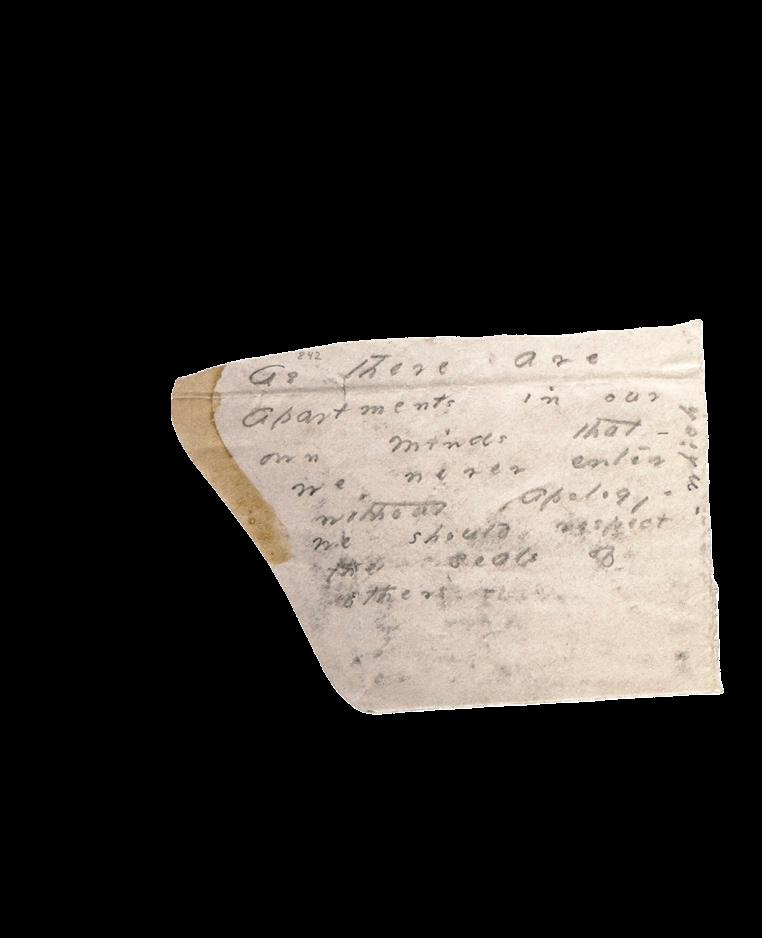
of an envelope or in its pocket is easy to imagine. This may explain why, to my eyes at least, the adversity covers always look like love letters (envelopes made with care have a particular resonance, at once emotional, psychic and bodily). There is in fact one example made of floral wallpaper, owned by Kauffman, which did contain a love letter, together with a small pressed fern leaf that plays, unconsciously perhaps, on the relationship between folds and foliations.
‘As there are / Apartments in our / own Minds that – / we never enter / without Apology – / we should respect / the seals / of others’, wrote Dickinson in one envelope poem, in the last decade of her life. There are no doubt many such apartments whose doors will be forever closed to us, and that is as it should be. When Dickinson died her death certificate listed her occupation as ‘at home.’13 It may be more than a matter of chance that, in the mid-nineteenth century, at the same time that the bourgeois domestic interior became a private refuge from the outside world, the mass-produced envelope should have privatised the letter.
Dickinson’s envelope poems play upon and invert these tropes, turning them inside out and outside in. Likewise the adversity covers. Wallpaper covered the walls of rooms or apartments in the privacy of the home, providing them with an internal envelope. A room was also an interior whose own exterior could be cut, pinched, creased, and folded into an envelope. ‘The Inner – paints the Outer – / The Brush without the Hand,’ to borrow Dickinson’s words from another set of poems. Though she was writing under different constraints, the adversity covers help us to see that the epistolary form Dickinson adopted was itself a fold – a fold in history, a fold within a fold, so to speak.
It takes a certain kind of sensibility to make such things, to feel free to repurpose materials as the means to communicate with others. A modernist paradigm is found in the figure of the ragpicker, who has long been connected to the modern poet.14 Finding value in detritus, the historical leftover, what gets cast out or abjected, all of this matters, and not only to poets. As many in this exhi bition show, artists can be ragpickers, too, revealing the same wish to salvage, the same mania for economy. After all, the envelope poems are visual things concerned with shape and pattern as much as they are textual things. Pro cesses of unfolding and cutting were as important to the composition of the poems as writing, and the experience of reading them hinges on how the support is held in the hand, whether you decide to turn a poem over, or around – they can be read in many ways.
Yet, like their Southern counterparts, Dickinson’s envelope poems offer a different paradigm with which to think the modern, quite unlike the ragpicker. Patternmak ing is as important as form, continuity as discontinuity. What counts is not only the fragment in its relation to an imagined whole or totality – melancholically held to be lost – but rather the fold, a figure of topology which, like the crease that secures it, opens up distinctions between the private and public, the interior life and the exterior one, the sensible and the intelligible.
RYE DAG HOLMBOE
Stefana McClure
Brahms:
German Requiem,
Stefana McClure
A
2016 Cut printed paper 39 cm circumference | 15.4 in circumference

Stefana McClure
Dragonball: a manga by Akira Toriyama, 2009 Cut printed paper
28 cm circumference | 11 in circumference


Susan Morris Susan Morris Plumb Line Drawing no.15 (Snow White/Spirit Level), 2010 Pure pigment (Sinopia) on paper in perspex box, erasure debris 26 × 21 × 154 cm | 10.2 × 8.3 × 60.6 in
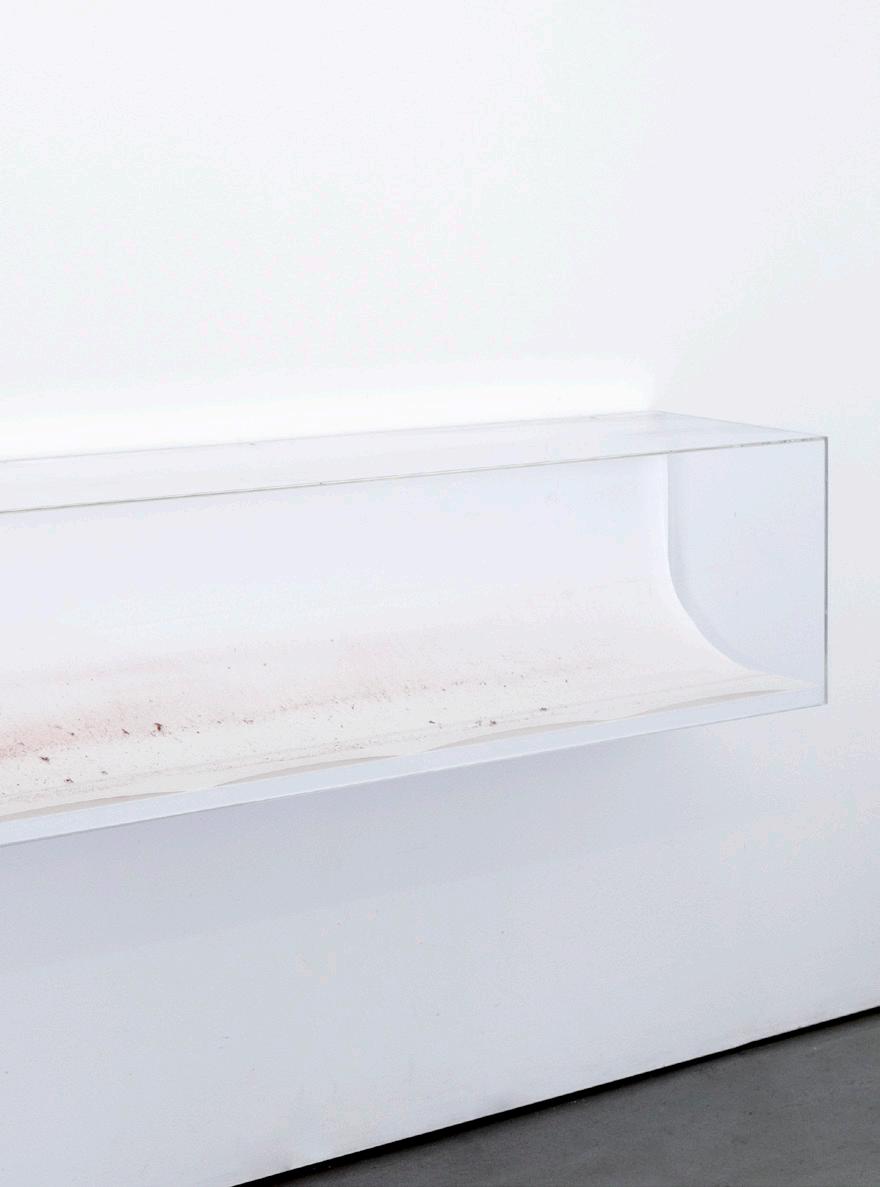
Susan Morris

Tickets to and From my Analyst, 2003 Bus tickets, bespoke plinth and perspex box 141 × 26 × 26 cm | 55.5 × 10.2 × 10.2 in


Matt Mullican
Untitled, (Representing the Work 1973 - 2022), 2022 Gesso, paper, glue and pencil on cotton sheet
260 × 153 cm | 102.4 × 60.2 in
Matt Mullican



Celia Pym Celia Pym Mended Ibuprofen Bag, 2022 Paper bag, wool and acrylic 26 × 18 × 18 cm | 10.2 × 7.1 × 7.1 in


Celia Pym Mended Baguette Bag, 2022 Paper bag, wool and linen 31 × 13 × 8 cm | 12.2 × 5.1 × 3.1 in
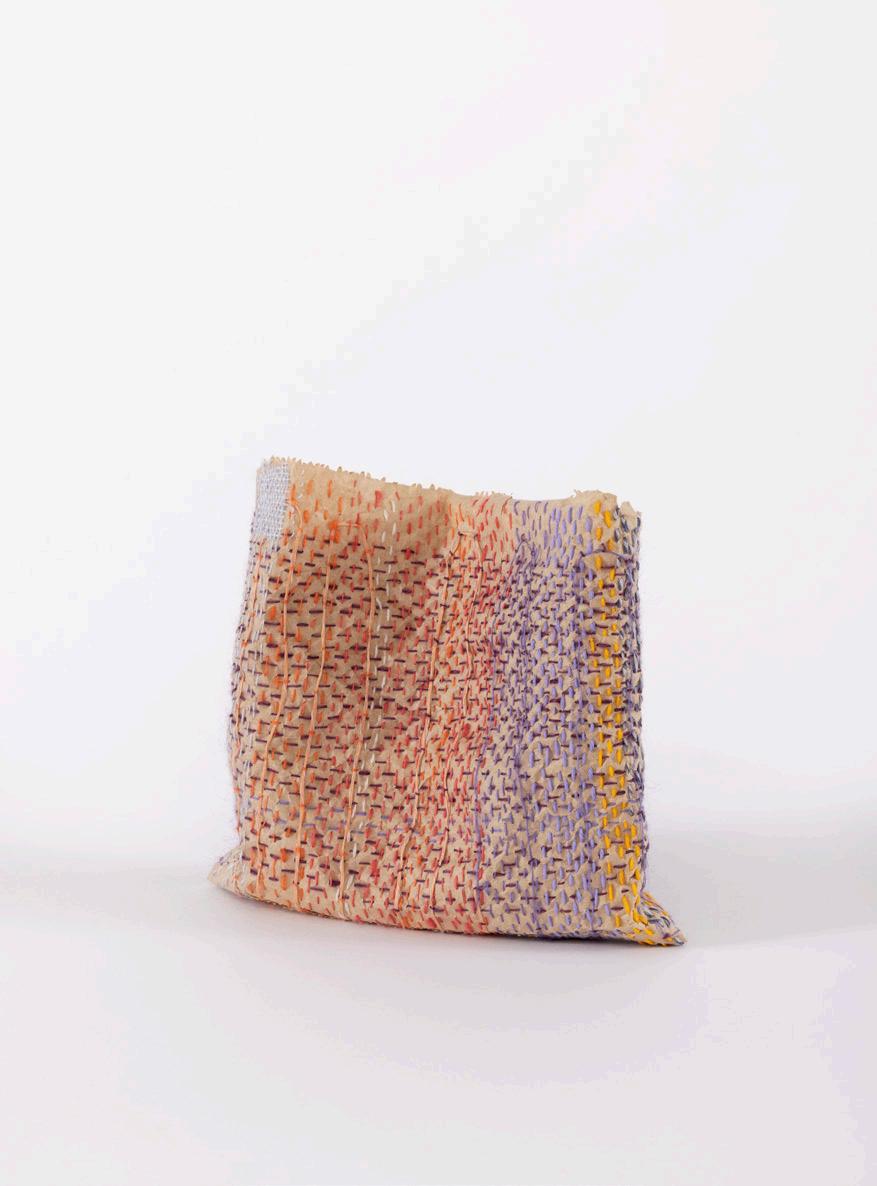
Celia Pym Mended Parsley Bag, 2022 Paper bag, mohair, paper yarn and cotton 20 × 20 × 9 cm | 7.9 × 7.9 × 3.5 in
Allyson Strafella

Allyson Strafella
Reverse and Front: rules for safe operation, 1978 - 2022 Found Instructions Envelope for Smith-Corona Typewriter and pencil marks 16.5 × 26 cm | 6.5 × 19.2 in

Allyson Strafella
after, 2000 - 2022

Typed marks on Abaca and carbon paper
Size variable

Igancio
Ignacio Uriarte
Uriarte Untitled, 2022 Typewriter on paper 21 × 29.7 cm | 8.3 × 11.7 in

Zinsser
LUCKY,
Charlotte
2021 Gesso and collage on found lottery tickets 38 × 10 cm | 15 × 4 in Charlotte Zinsser


Charlotte Zinsser EGO, 2021 Marker on found paper 8.5 × 11.8 cm | 3.2 × 4.6 in

Charlotte Zinsser FAIRNESS, 2021 Marker on found paper 21.5 × 15 cm | 8.4 × 5.9 in

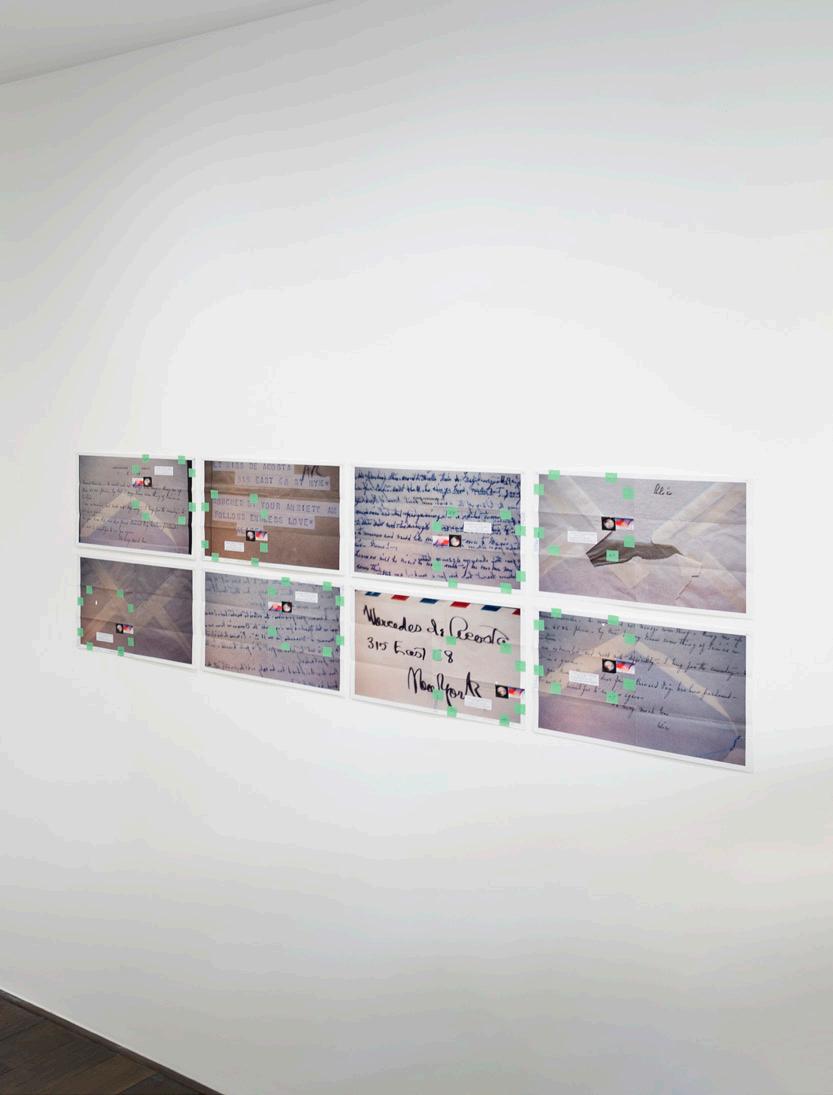
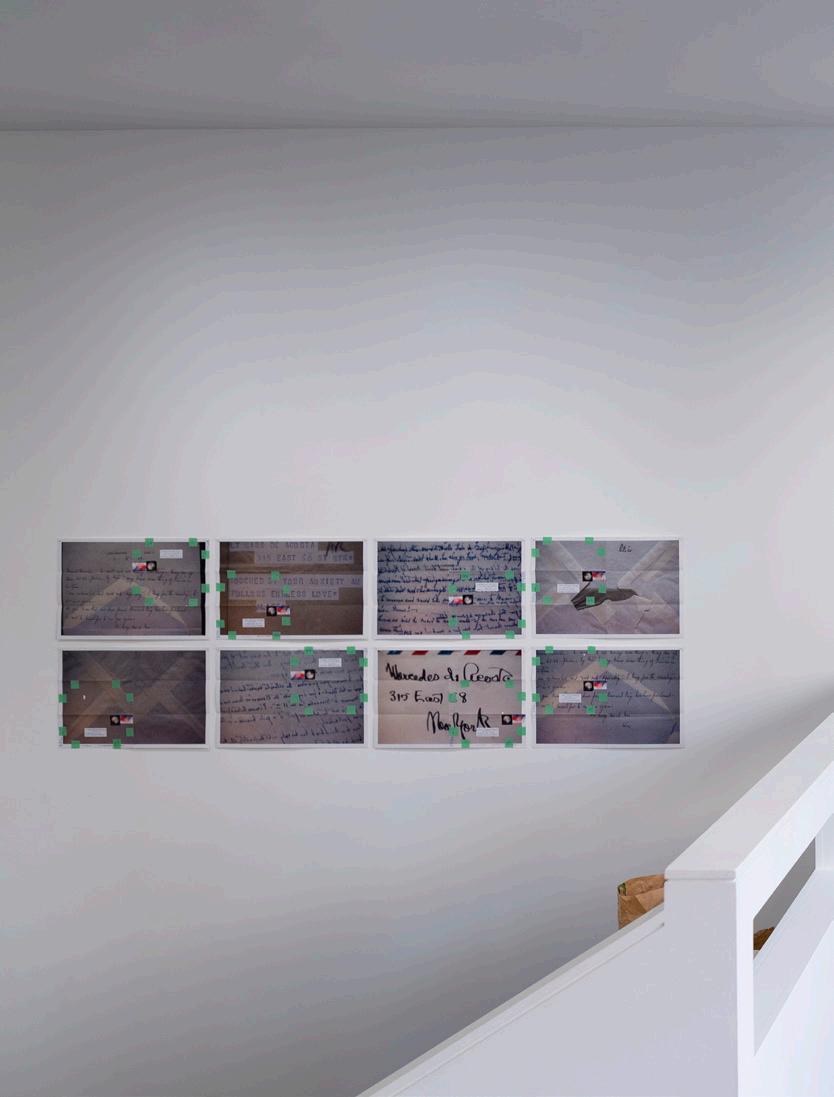




Anna Barham (British, b. 1974)
Lives and works in London
Courtesy Arcade, London
Florian Baudrexel (German, b. 1968)
Lives and works in Berlin
Courtesy Linn Lühn, Düsseldorf
Erica Baum (American, b. 1961)
Lives and works in New York
Courtesy Galerie Crèvecœur, Paris
Moyra Davey (Canadian, b. 1958)
Lives and works in New York
Courtesy greengrassi, London
Tacita Dean (British/German, b. 1965)
Lives and works in Berlin and Los Angeles
Courtesy Marian Goodman Gallery, Paris
Mathew Hale (British/German, b. 1958)
Lives and works in Berlin and Los Angeles
Stefana McClure (British, b. 1959)
Lives and works in Newburgh, NY
Susan Morris (British, b. 1962)
Lives and works in London
Matt Mullican (American, b. 1951)
Lives and works in Berlin and New York
Courtesy Mai 36, Zürich
Celia Pym (British/American, b. 1978)
Lives and works in London
Allyson Strafella (American, b. 1969)
Lives and works in Hudson, NY
Ignacio Uriarte (German, b. 1972)
Lives and works in Berlin and Valencia
Courtesy Philipp von Rosen, Cologne
Charlotte Zinsser (American, b. 1999)
Lives and works in Brooklyn, NY
Susan Morris: Gorgeous Nothings
1 Susan Howe, ‘These Flames and Generosities of the Heart: Emily Dickinson and the Illogic of Sumptuary Values,’ The Birth-mark: Unsettling the Wilderness in American History, Wesleyan University Press, 1993, 141.
2 Mel Bochner, Working Drawings and Other Visible Things on Paper Not Nec essarily Meant to be Viewed as Art, Walter König, Köln, 1997
3 James Joyce, Ulysses, Oxford University Press, 1998, 144.
4 Geoff Ward, ‘Throwaway: Joyce’s Heroic Inutility’, Re: Joyce. Text. Culture. Politics, Palgrave Macmillan, 1998, 146160 Rye Dag Holmboe: Fold
1 Jane Bervin, ‘Studies in Scale’ in: eds. Marta Werner & Jen Bervin, Emily Dickinson: The Gorgeous Nothings, Chris tine Burgin / New Directions, New York, 2013, 8.
2 Bervin, ‘Studies in Scale’, 9.
3 Alfred Habegger, My Wars Are Laid Away in Books, Penguin, London, 2002, 436. See also Hillary Kelly, ‘Master Narrative: Who Did Emily Dickinson Write Her Love Letters To?’, Los Angeles Review of Books, July 22, 2012.
4 James Ward, Adventures in Stationary: A Journey Through Your Pencil Case, Profile Books, 2014.
5 Bervin, ‘Studies in Scale’, 11.
6 Thomas Wentworth Higginson, cited in: The Gorgeous Nothings, 12.
7 See Winifred Gallagher, ‘A Brief History of the United States Postal Service’, Smithsonian Magazine, October 2020.
https://www.smithsonianmag.com/ smithsonian-institution/brief-history-unit ed-states-postal-service-180975627/ See also Boyce Upholt, ‘The Tumultuous History of the U.S. Postal Service – And its Constant Fight for Survival’, National Geographic, May 2020. https://www.nationalgeographic. com/history/article/tumultuous-his tory-united-states-postal-service-con stant-fight-survival
8 See Chapter 4 of Alexis McCros
sen, Marking Modern Times: A History of Clocks, Watches, and Other Time Keepers in American Life, University of Chicago Press, Chicago and London, 2013.
9 Dickinson, cited in: Jerusha Hull McCormack, ‘Domesticating Delphi: Emily Dickinson and the Electro-Magnetic Tele graph’, American Quarterly, volume 55, no.4, December 2023, 574.
10 Dickinson, cited in McCormack, ‘Domesticating Delphi’, 574.
11
Patricia A. Kauffman, ‘Resilience in Hard Times: Adversity Covers’ in Stamp Collectors Quarterly, issue no.12, np.
12 Kauffman, ‘Resilience in Hard Times’, np.
13
Martha Ackmann, These Fevered Days: Ten Pivotal Moments in the Making of Emily Dickinson, W. W. Norton & Company, New York, 2020, xiii.
14 The most well-known example is Walter Benjamin’s essay on Charles Baudelaire.
Endnotes

Susan Morris Expenditure II, 2012 Folded paper Dimensions variable
Published on the occasion of:
The Gorgeous Nothings
Curated by Susan Morris
October 6 - November 2, 2022
Photocredits
Anna Barham: Andy Keate
Tacita Dean: Alex Yudzon
Susan Morris: George Kraniotis
Celia Pym: Michele Panzeri
Allyson Strafella: Maximilian Goldfarb
Copyright
The Authors and artists and respective galleries.
Bartha Contemporary Ltd.
We would like to especially thank Susan Morris for her immeasurable contribution to this project.
We would like to thank Arcade, Linn Lühn, Galerie Crèvecœur and Bureau Inc, greengrassi, Marian Goodman Gallery, Mai36 and Philipp von Rosen for their collaboration.
We would also like to thank Matteo Fargion, Jen Bervin, Nicolas Linnert, Cleo Walker, Simon Hanzer, Albrecht Pischel, Edwige Cochois, Emma Simon, Katia Kuznetsova, Victor Gisler, Justine Hauer, Eleanor Royer and Anaïs de Balincourt for their help.
Most and foremost we would like to thank the participating artists for their generosity, which without a doubt set the tone for this unique exhibition project.
Daniela & Niklas von Bartha
BARTHA CONTEMPORARY WWW.BARTHACONTEMPORARY.COM INFO@BARTHACONTEMPORARY.COM www.thegorgeousnothings.show
BARTHA CONTEMPORARY



























































